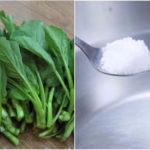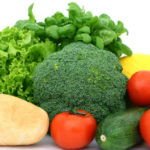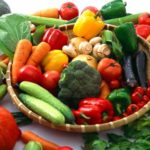Boiled vegetables are a staple in every household, but there has been much debate about whether one should “open or close the lid when boiling vegetables?” What is the wise thing to do to minimize nutrient loss while still removing toxins harmful to the body?
Vegetables contain a large amount of organic acids, some of which can be harmful to the body. These organic acids will evaporate during cooking. Therefore, when boiling vegetables, it is advisable to leave the lid open to remove toxins harmful to the body. Additionally, given the current food safety concerns, some believe that leaving the lid open when boiling vegetables can help release some of the chemicals with the steam.
Moreover, keeping the lid open also helps retain the chlorophyll and magnesium content in the vegetables, maintaining their green color.

What about boiling vegetables with the lid closed? Research has shown that if you boil vegetables with the lid on, you will lose about 15% of the available vitamins, but leaving the lid open will result in a loss of 32%. This means that the vegetables will only have fiber and not a rich source of natural vitamins.
So, both methods have their pros and cons. What is the right way to boil vegetables, then?
In fact, preserving nutrients starts with how you prepare and clean the vegetables before cooking.
Firstly, it is recommended to wash the vegetables before cutting them. If you cut the vegetables and then soak them in water, you will lose 14-23% of the vitamins. Additionally, when washing vegetables, you should not soak them in water for too long as green vegetables contain a lot of water themselves. Based on the principle of osmosis, if you soak the vegetables in water for an extended period, the outer water will enter the vegetables to reach a balanced state. When the cell walls are broken due to excessive water intake, the cell sap will dissolve into the external water.

It is also not advisable to cook the vegetables too long before mealtime as, during the cooking process, water and nutrients in the vegetables are separated.
Furthermore, when washing vegetables, you should not soak them in water for too long, as green vegetables themselves contain a lot of water. Based on the principle of osmosis, if you soak the vegetables in water for an extended period, the outer water will enter the vegetables, creating a balanced solution. When the cell walls are compromised due to excessive water intake, the intracellular fluid will dissolve and mix with the external water.
After cutting, if the vegetables are soaked in water, there will be a loss of 14-23% of vitamins. If soaked overnight, almost all vitamin C will be lost. Other water-soluble nutrients, such as vitamin B group or minerals, and proteins will also be lost in a similar manner.

Here are some additional tips to consider when boiling vegetables:
– When the water boils, add a little salt to preserve the color of the vegetables. A reasonable ratio is one teaspoon of salt for every half liter of water.
– Wait for the water to boil before adding the vegetables (as many vitamins are lost and dissolved immediately after the vegetables are put into the water). Boil for about 2-5 minutes, depending on the type of vegetable. Boil the vegetables over medium or high heat. If you boil them over low heat, the temperature will not be sufficient to retain the green color and will cause the dissolution of vitamins C and B1 during the boiling process. Even when eating a boiled vegetable that is mushy and not sweet, you will find it bland and less appetizing.
– When the vegetables are cooked, use a slotted spoon to remove them and place them in a bowl of clean water with a few ice cubes. Once the vegetables have cooled, drain and set aside. This will ensure that they remain tasty, crisp, and not soggy.
– Eating vegetables immediately after preparation is also essential to maximizing their nutritional value. Waiting for more than an hour will result in a 25% loss of vitamins, and after two hours, the loss increases to 35-47%. Moreover, if you reheat pre-cooked vegetables, up to 90% of the vitamins will be lost. Therefore, it is not advisable to keep vegetables overnight, as their nutritional value will be significantly reduced.
The best way to preserve the most vitamins in vegetables is to steam them instead of boiling them, ensuring that the vitamins remain in the vegetables rather than leaching out into the water.
According to Nhịp Sống Việt
How to Steam Vegetables Without Water While Keeping Nutritional Quality
 Vegetables Without Water While Keeping Nutritional Quality’>
Vegetables Without Water While Keeping Nutritional Quality’>Are you looking for an efficient and nutritious way to cook your vegetables? XANH Appliances has the answer with two incredible methods of boiling vegetables without the need for water. Find out how to make the most of your vegetables with XANH Appliances!




































